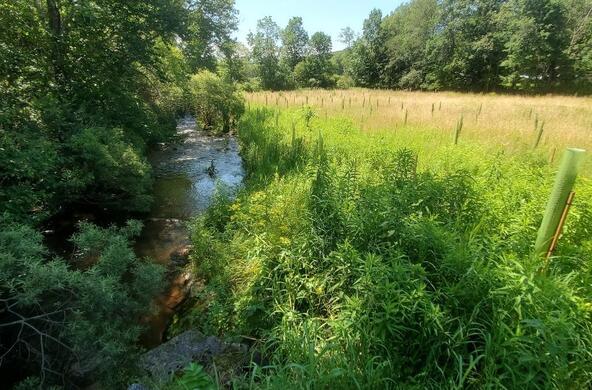As I walk along the shore of our property in Maine, I am astounded at the amount of human debris that washes up on the beach. Nylon rope and plastic bottles dominate the flotsam, but bottle caps are probably the most numerous item. And every now and again, I encounter one of the large plastic crates that fishermen use to bring their catch to market. My wife and I clean up the beach a couple of times a year, and we never come back empty-handed.
We live in a fishing village, so perhaps we have a larger than average dose of plastic washing down our bay to the sea. But, evidence suggests that plastic pollution of the seas is a global problem. A recent study reported that every day 4.1 tons of plastic washes down the Danube, Europe’s second largest river, to the Black Sea. In the Danube, more than 300 plastic particles are found per 1000 m3 of river water. The weight of these plastic particles exceeds that of larval fishes in the same volume. Human debris in the river exceeds nature’s productivity.
Worldwide production of plastics approaches 300 million tons per year, and a recent estimate suggests that 4.8 to 12.7 million tons reaches the sea. It is hard to know exactly, because the sources are diffuse and some plastics, such as grocery bags and balloons, are carried to the sea by the winds. Various oceanographic expeditions have reported vast rafts of plastic—bottles, flip-flops, nets, and bottle caps—swirling in the central oceanic gyres of the Atlantic and the Pacific oceans. Old mariners report that the problem is much worse now than 20 years ago.
Plastics are more than an aesthetic problem in the marine environment. Larger pieces of plastic debris are degraded by sunlight, in a process known as photo-oxidation, and fragment into smaller pieces, which can be a millimeter or less in diameter. Small pieces of plastic, such as bottle caps and fragments, are easily ingested by marine organisms, such as albatross, seals and whales. The smallest fragments of plastic can be eaten by zooplankton and passed up the marine food chain. The ingestion of plastics is not an occasional event. Plastics in the stomachs of the Northern Fulmar, a pelagic seabird, provide a good measure of the plastic contamination measured in seawater by independent means.
Sinking and consumption by animals mean that plastics disappear from seawater fairly rapidly, so that the mean life-time of the plastics in the surface water is about 20 days.[1] This does not mean that the plastic is gone; most plastic molecules are thought to persist for hundreds, if not thousands of years, in the sediments.
Fragments and pellets derived directly from the plastics industry have declined in recent years, reflecting a worldwide effort on the part of manufacturers to develop Best Management Practices (BMPs) to keep their product out of nature. But, plastics derived from retail products are increasing in many areas. Only a small fraction of the world’s annual production of plastic is recycled—about 30% in the U.S.—so a lot of it is left where it can wash (or blow) to the sea. In some areas, plastic water bottles are not even accepted at recycling centers, because they have so little value as scrap.
Plastics have improved our daily life in many ways, bringing fresh water in bottles to many regions where municipal water is contaminated or unavailable and allowing sterile medical procedures in hospitals throughout the world. Most plastic is used in packaging, which has a short life time before disposal. It behooves us to minimize that packaging, including bans on the use of plastic bags in grocery stores. And, it behooves us to collect and recycle as much of the waste as possible, even if it costs us a little to do so.
About 40 years ago, in "The Graduate," Mr. McGuire was right to advise the young Ben Braddock, played by Dustin Hoffman, to pursue a career in plastics. Today, the accumulation of plastic waste in the environment leaves a geologic record of the globalization of our disposable economy.
References:
Corcoran, P.L., T. Norris, T. Ceccanese, M.J. Walzak, P.A. Helm and C.H. Marvin. 2015. Hidden plastics of Lake Ontario, Canada and their potential preservation in the sediment record. Environmental Pollution 204: 17-25.
Eriksen, M., L.C.M. Lebreton, H.S. Carson, M. Thiel, C.J. Moore, J.C. Borrero, F. Galgani, P.G. Ryan, and J. Reisser. 2014. Plastic pollution in the world’s oceans: more than 5 trillion plastic pieces weighing over 250,000 tons afloat at sea. PLos One 9 (12) p.e111913[1]
Jambeck, J.R., R. Geyer, C. Wilcox, T.A. Siegler, M. Perryman, A. Andrady, R. Narayan and K.L. Law. 2015. Plastic waste inputs from land into the ocean. Science 347: 768-771.
Lechner, A., H. Keckeis, F. Lumesberger-Loisl, B. Zens, R. Krusch, M. Tritthart, M. Glas and E. Schludermann. 2014. The Danube so colorful: a potpourri of plastic litter outnumbers fish larvae in Europe’s second largest river. Environmental Pollution 188: 177-181.
Moore, C. and C. Phillips. 2011. Plastic Ocean. Avery/Penguin, New York.
Van Franeker, J.A. and K.L. Law. 2015. Seabirds, gyres, and global trends in plastic pollution. Environmental Pollution 203: 89-96.
[1] Calculated by dividing an estimate of the amount of plastic debris in the oceans (270,000 tons; Eriksen et al. 2014) by the lower estimate for the annual input (Jambeck et al. 2015), resulting in a mean residence time of 0.056 years, which is slightly more than 20 days.








